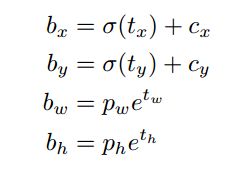YOLO v3解析与实现
前言
又到了一年考试周,去年本来想实现深度学习目标检测,结果因为各种问题没有做,现在趁机会实现一下。
YOLOv3在YOLOv2的基础进行了一些改进,这些更改使其效果变得更好。 在320×320的图像上,YOLOv3运行速度达到了22.2毫秒,mAP为28.2。其与SSD一样准确,但速度快了三倍,具体效果如下图。本文对YOLO v3的改进点进行了总结,并实现了一个基于Keras的YOLOv3检测模型。
inference
Paper:YOLOv3: An Incremental Improvement
Official website:https://pjreddie.com/darknet/yolo
Github:https://github.com/xiaochus/YOLOv3
环境
Python 3.6
Tensorflow-gpu 1.5.0
Keras 2.1.3
OpenCV 3.4
改进点
1.Darknet-53特征提取网络
不同于Darknet-19,YOLO v3中使用了一个53层的卷积网络,这个网络由残差单元叠加而成。根据作者的实验,在分类准确度上跟效率的平衡上,这个模型比ResNet-101、 ResNet-152和Darknet-19表现得更好。
Darknet-53
2.边界框预测
基本的坐标偏移公式与YOLO v2相同。

box
YOLO v3使用逻辑回归预测每个边界框的分数。 如果先验边界框与真实框的重叠度比之前的任何其他边界框都要好,则该值应该为1。 如果先验边界框不是最好的,但确实与真实对象的重叠超过某个阈值(这里是0.5),那么就忽略这次预测。YOLO v3只为每个真实对象分配一个边界框,如果先验边界框与真实对象不吻合,则不会产生坐标或类别预测损失,只会产生物体预测损失。
3.类别预测
为了实现多标签分类,模型不再使用softmax函数作为最终的分类器,而是使用logistic作为分类器,使用 binary cross-entropy作为损失函数。
4.多尺度预测
不同于之前的YOLO,YOLO v3从三种不同尺度的特征图谱上进行预测任务。
在Darknet-53得到的特征图的基础上,经过7个卷积得到第一个特征图谱,在这个特征图谱上做第一次预测。
然后从后向前获得倒数第3个卷积层的输出,进行一次卷积一次x2上采样,将上采样特征与第43个卷积特征连接,经过7个卷积得到第二个特征图谱,在这个特征图谱上做第二次预测。
然后从后向前获得倒数第3个卷积层的输出,进行一次卷积一次x2上采样,将上采样特征与第26个卷积特征连接,经过7个卷积得到第三个特征图谱,在这个特征图谱上做第三次预测。
每个预测任务得到的特征大小都为N ×N ×[3∗(4+1+80)] ,N为格子大小,3为每个格子得到的边界框数量, 4是边界框坐标数量,1是目标预测值,80是类别数量。

out
实验
实现了一个输入大小为(416, 416)的yolo v3检测模型,模型使用了coco训练的权值文件。
权值文件转换
参考了yad2k项目的转换方法,我们为其添加了几个新的层,用来将Darknet的网络结构和权值文件转换为keras 2的网络结构和权值文件。
首先下载权值文件yolov3.weights
执行下列命令转换
python yad2k.py cfg\yolo.cfg yolov3.weights data\yolo.h5检测
demo.py文件提供了使用yolo v3进行检测的例子。图片检测结果输出到images\res文件夹。
"""Demo for use yolo v3
"""
import os
import time
import cv2
import numpy as np
from model.yolo_model import YOLO
def process_image(img):
"""Resize, reduce and expand image.
# Argument:
img: original image.
# Returns
image: ndarray(64, 64, 3), processed image.
"""
image = cv2.resize(img, (416, 416),
interpolation=cv2.INTER_CUBIC)
image = np.array(image, dtype='float32')
image /= 255.
image = np.expand_dims(image, axis=0)
return image
def get_classes(file):
"""Get classes name.
# Argument:
file: classes name for database.
# Returns
class_names: List, classes name.
"""
with open(file) as f:
class_names = f.readlines()
class_names = [c.strip() for c in class_names]
return class_names
def draw(image, boxes, scores, classes, all_classes):
"""Draw the boxes on the image.
# Argument:
image: original image.
boxes: ndarray, boxes of objects.
classes: ndarray, classes of objects.
scores: ndarray, scores of objects.
all_classes: all classes name.
"""
for box, score, cl in zip(boxes, scores, classes):
x, y, w, h = box
top = max(0, np.floor(x + 0.5).astype(int))
left = max(0, np.floor(y + 0.5).astype(int))
right = min(image.shape[1], np.floor(x + w + 0.5).astype(int))
bottom = min(image.shape[0], np.floor(y + h + 0.5).astype(int))
cv2.rectangle(image, (top, left), (right, bottom), (255, 0, 0), 2)
cv2.putText(image, '{0} {1:.2f}'.format(all_classes[cl], score),
(top, left - 6),
cv2.FONT_HERSHEY_SIMPLEX,
0.6, (0, 0, 255), 1,
cv2.LINE_AA)
print('class: {0}, score: {1:.2f}'.format(all_classes[cl], score))
print('box coordinate x,y,w,h: {0}'.format(box))
print()
def detect_image(image, yolo, all_classes):
"""Use yolo v3 to detect images.
# Argument:
image: original image.
yolo: YOLO, yolo model.
all_classes: all classes name.
# Returns:
image: processed image.
"""
pimage = process_image(image)
start = time.time()
boxes, classes, scores = yolo.predict(pimage, image.shape)
end = time.time()
print('time: {0:.2f}s'.format(end - start))
if boxes is not None:
draw(image, boxes, scores, classes, all_classes)
return image
def detect_vedio(video, yolo, all_classes):
"""Use yolo v3 to detect video.
# Argument:
video: video file.
yolo: YOLO, yolo model.
all_classes: all classes name.
"""
camera = cv2.VideoCapture(video)
cv2.namedWindow("detection", cv2.WINDOW_NORMAL)
while True:
res, frame = camera.read()
if not res:
break
image = detect_image(frame, yolo, all_classes)
cv2.imshow("detection", image)
if cv2.waitKey(110) & 0xff == 27:
break
camera.release()
if __name__ == '__main__':
yolo = YOLO(0.6, 0.5)
file = 'data/coco_classes.txt'
all_classes = get_classes(file)
# detect images in test floder.
for (root, dirs, files) in os.walk('images/test'):
if files:
for f in files:
print(f)
path = os.path.join(root, f)
image = cv2.imread(path)
image = detect_image(image, yolo, all_classes)
cv2.imwrite('images/res/' + f, image)
# detect vedio.
video = 'E:/video/car.flv'
detect_vedio(video, yolo, all_classes)结果
